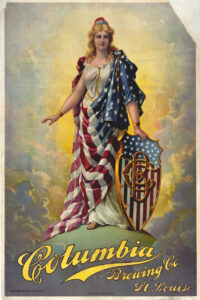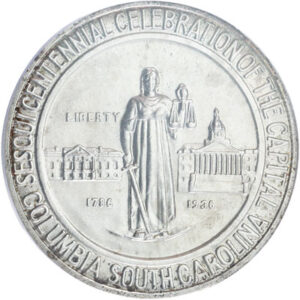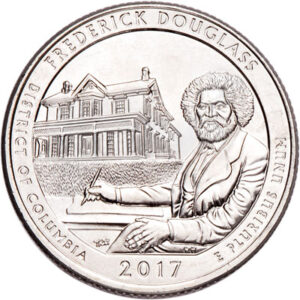Did Uncle Sam Have a Sister?

She’s given short shrift in modern U.S. history, but the Goddess Columbia enjoyed an early try-out as the symbol of America in the 17th and 18th centuries. Back then, European culture prized progress as the colonists forged a new civilization in the North American wilderness. Given the female allegories of Britannia associated with England and Marianne, with France, it wasn’t long before a feminine version of Columbus emerged as a mythical, and non-theological, Goddess Columbia.
Over time, and with changes in political messaging, Uncle Sam and Lady Liberty overtook Columbia as America’s new symbols that emphasized independence and freedom. Yet, Columbia is associated with four different collectible coins. Let’s take a look at how that happened.
Of all the capitals in the country

The hat tip goes to South Carolina. It was the only state ever to choose Columbia as the name for its capital. Although the U.S. Mint recast her as Justice, holding a sword and scales, you can see her commemorated here on this 1936 silver half dollar. It was issued on the 150th anniversary of the state Assembly’s vote to move the capital from the seacoast to a more central location inland in 1786. Apparently, there had been considerable argument over the name for the new city. One legislator insisted on Washington, but Columbia won by a vote of 11-7 in the state Senate.
Four short years later, Congress passed the Residence Act of 1790. It was designed to fulfill the U.S. Constitution’s promise to secure a location “not exceeding ten Miles square” for the seat of the new federal government. The chosen territory was renamed Washington, District of Columbia. In 1800, all federal business moved from Philadelphia one last time to this final location on the Potomac and Anacostia Rivers.
There are two quarters associated with Washington, D.C. The first one is the coin issued in 2009 as an extension of the mint’s popular Statehood quarter series. That year, six additional designs were released honoring the District of Columbia, plus the five U.S. territories. The D.C. reverse honored famous jazz musician Duke Ellington, who was born in his grandmother’s rowhouse on the then-named Ida Place. Long gone and now called Ward Place NW, it would be the first of eight different homes in which the jazz great grew up.

The other coin struck to represent the District of Columbia is found in the mint’s next series, National Park Quarters. Sitting on eight acres known as Cedar Hill, the single-family home where abolitionist Frederick Douglass spent the last 17 years of his life is honored as a National Historic Site on a 2017 quarter.
New Frontier
In 1981, NASA launched its first of five space shuttles designed to take off like a rocket and land like an airplane. On the shuttle’s 40th anniversary, a commemorative coin was released for Ghana in precious titanium. Named Columbia, the shuttle paid tribute to the first American-made ship to circumvent the Western Hemisphere and explore the Pacific Northwest in 1792. Fur trader and captain of the three-masted ship, Robert Gray, renamed the Rio de San Roque (first discovered by Spanish explorers) the Columbia River. He did so after sighting its tidewater at what would later be called Astoria, OR.
Coincidentally, or not, Columbia was built in the greater Boston area where some historical researchers say Salem witch trial judge, Samuel Sewall, wrote a poem in 1697 suggesting the colonies be called Columbina. But it was the poem His Excellency General Washington published in 1776 that solidified the spelling we recognize today. It was written by the African American slave Phillis Wheatley at the start of Washington’s campaign against the British.
Living with the Wheatley family, who later freed her after the London publication of her first book of poems, Phillis had penned this verse:
Fix’d are the eyes of nations on the scales,
For in their hopes Columbia’s arm prevails.
Anon Britannia droops the pensive head,
While round increase the rising hills of dead.
Ah! Cruel blindness to Columbia’s state!
Lament thy thirst of boundless power too late.
Goddess Columbia’s early role may lie in a forgotten drawer of history, but towns in New Hampshire, Missouri and California, as examples, plus countless street names, still bear witness to the colonial ideal of progress. And, of course, commemorative coins, too!
SOURCES
Gutierrez, Jeanne. Allegories of America: “American Woman? Amérique, Columbia, and Lady Liberty.” New York Historical Society, October 23, 2018. https://www.nyhistory.org/blogs/american-woman-amerique-columbia-and-lady-liberty
“A Brief History of Columbia.” Accessed April 12, 2023. https://columbiasc.gov/about-columbia/
George Washington’s Mount Vernon. “Residence Act of 1790.” Accessed April 12, 2023 https://www.mountvernon.org/education/primary-source-collections/primary-source-collections/article/residence-act-of-1790/#:~:text=An%20ACT%20for%20establishing%20the,Government%20of%20the%20United%20States.
“Frequently Ask Questions about Statehood for the People of DC.” Accessed April 12, 2023. https://statehood.dc.gov/page/faq
U.S. National Park Service. “Duke Ellington Birthplace Site.” Accessed April 12, 2023. http://www.historyshomes.com/detail.cfm?id=780.
U.S. National Park Service. “Frederick Douglass National Historic Site.” Accessed April 12, 2023. https://www.nps.gov/frdo/index.htm
Haswell, Robert. Witness to America’s Past: “A Voyage Round the World Onboard the Ship Columbia Rediviva and Sloop Washington.” Massachusetts Historical Society, September 1787-June 1789. https://www.masshist.org/database/viewer.php?item_id=193&pid=15



